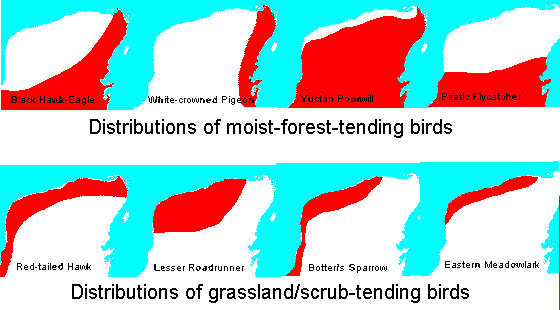BIRD BIOGEOGRAPHY
in the Yucatán

Barbara MacKinnon H.'s checklist of Yucatan Birds lists 537 species in 74 bird families. About 50% of all of Mexico's bird species are found in the Yucatan and some 58% of all North American birds are found here. Some 128 species from North America regularly overwinter in the Yucatan, while some 54 species pass through the Yucatan during spring and/or fall migration, but nest farther north, and overwinter farther south than here. About 58 species are considered vagrants or occasional visitors. That's a lot, largely because during fall migration, in September and October, the Yucatan is subject to tropical storms and "northers" that blow birds far from where they want to be.
The Yucatan birdlist contains a surprisingly high percentage of endemic birds -- species that in the whole world are found only in the Yucatan. Barbara Mackinnon lists 14 species and about 100 subspecies.
Cozumel Island off Yucatan's eastern coast is home to three species found nowhere else on Earth:
The following species are found only in the bioregion comprising the Yucatan Peninsula, parts of Belize, northern Guatemala and western Tabasco.
The reason for so many endemics is easy to understand. Unique species tend to evolve on islands where gene flow from surrounding populations is cut off, allowing island-bound birds to evolve to their own local conditions. The Yucatan Peninsula is an "ecological island." It is surrounded by water in the east, west and north, and, in the south, the moist, lush forests and marshes found there are ecologically very different from the arid north. To Yucatan birds adapted to dry, scrubby environments, the tall, humid forests of the south are nothing less than ecological walls. You may want to review our Vegetation of the Yucatan Page where we discuss the Yucatan's rainfall patterns.
If you only stay in northern, inland Yucatan, you'll miss a very large percentage of the birds on the Yucatan checklist. That's because the southern Yucatan with its much greater rainfall and consequent more luxuriant vegetation has a considerably higher species diversity than the north -- not only for birds but also for trees, wildflowers, reptiles, insects, and just about everything else. This make sense because we all know that deserts have fewer species than rainforests. On the other hand, often desert organisms are fabulously interesting because of their remarkable adaptations to very difficult conditions.
In fact, if you thumb through the distribution maps of birds found in the Yucatan again and again you'll see maps similar to those shown below -- forest-loving birds with distributions coming up from the southeast, and grassland- or scrub-loving birds with distributions mostly in the northwest.

Of course, if you visit northern Yucatan's coastal wildlife reserves, then species diversity skyrockets, for in those marshes and estuaries there is plenty of water. However, in the coastal reserves -- Celestún, Río Lagartos and elsewhere -- many of the shore, marsh and open-water birds are the very same species you'll see in coastal Louisiana, Florida, and farther north along North America's coasts. However, in these marshes there will be a few spectacular species you won't see farther north, such as the flamingos, plus there are other kinds of plants and animals definitely not found in North America.